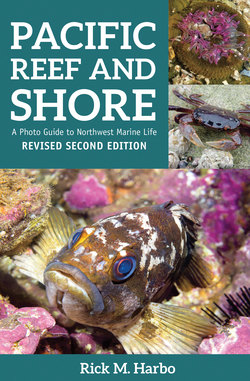Читать книгу Pacific Reef and Shore - Rick M. Harbo - Страница 9
ОглавлениеNudibranchs (Sea Slugs)
Phylum Mollusca
Nudibranchs are colourful—sometimes spectacular—favourites of tidepool explorers and divers. Many species have a retractable plume-like gill projection or numerous cerata (protrusions), shaped like fingers, paddles or clubs. Some also have papillae (finger-like projections) or tubercles (bumps) on the body for respiration, camouflage and defence.
Dorid Nudibranchs
Features include flattened body, retractable gill plume and rhinophores (paired sensory organs on the head). Dorids lay lacy ribbons of eggs.
Spotted Leopard Dorid
Diaulula odonoghuei
To 3” (7.5 cm) long. Elongated oval body with fine tubercles (bumps). Dark brown spots, solid or occasionally ring-shaped, that extend onto the mantle margin. On rocks and sponges, intertidal to 115’ (35 m) deep. D. sandiegensis is more humped and has only a few dark rings or spots on body, found on open coast.
Monterey Sea Lemon
Doris montereyensis
To 6” (15 cm) long. Slender. Yellow to orange; scattered dark tubercles (bumps). Gills yellow colour. Feeds on sponges. Usually intertidal, but subtidal to 165’ (50 m) deep.
Red Nudibranch
Rostanga pulchra
To 5/8” (1.5 cm) long. Oval. Red-orange, sometimes with brown to black spots. Lays red ribbons of eggs and feeds on the velvety red sponge (p. 77). Intertidal and shallow subtidal, to 65’ (20 m).
Clown Dorid
Triopha catalinae
To 6” (15 cm) long. Slender body. White with orange on rhinophores (paired sensory organs on the head), front veil, tubercles (bumps) and gill plume. Feeds on spiral bryozoans (p. 83). Intertidal to 115’(35 m) deep.
Noble Sea Lemon
Doris nobilis
